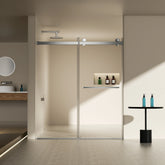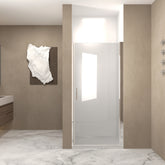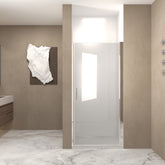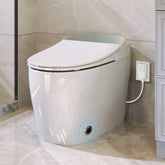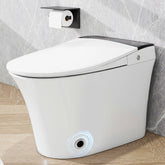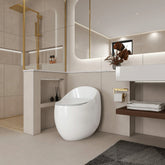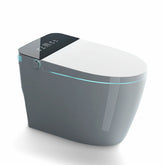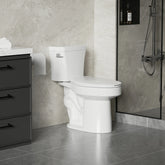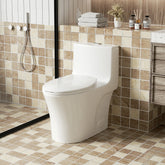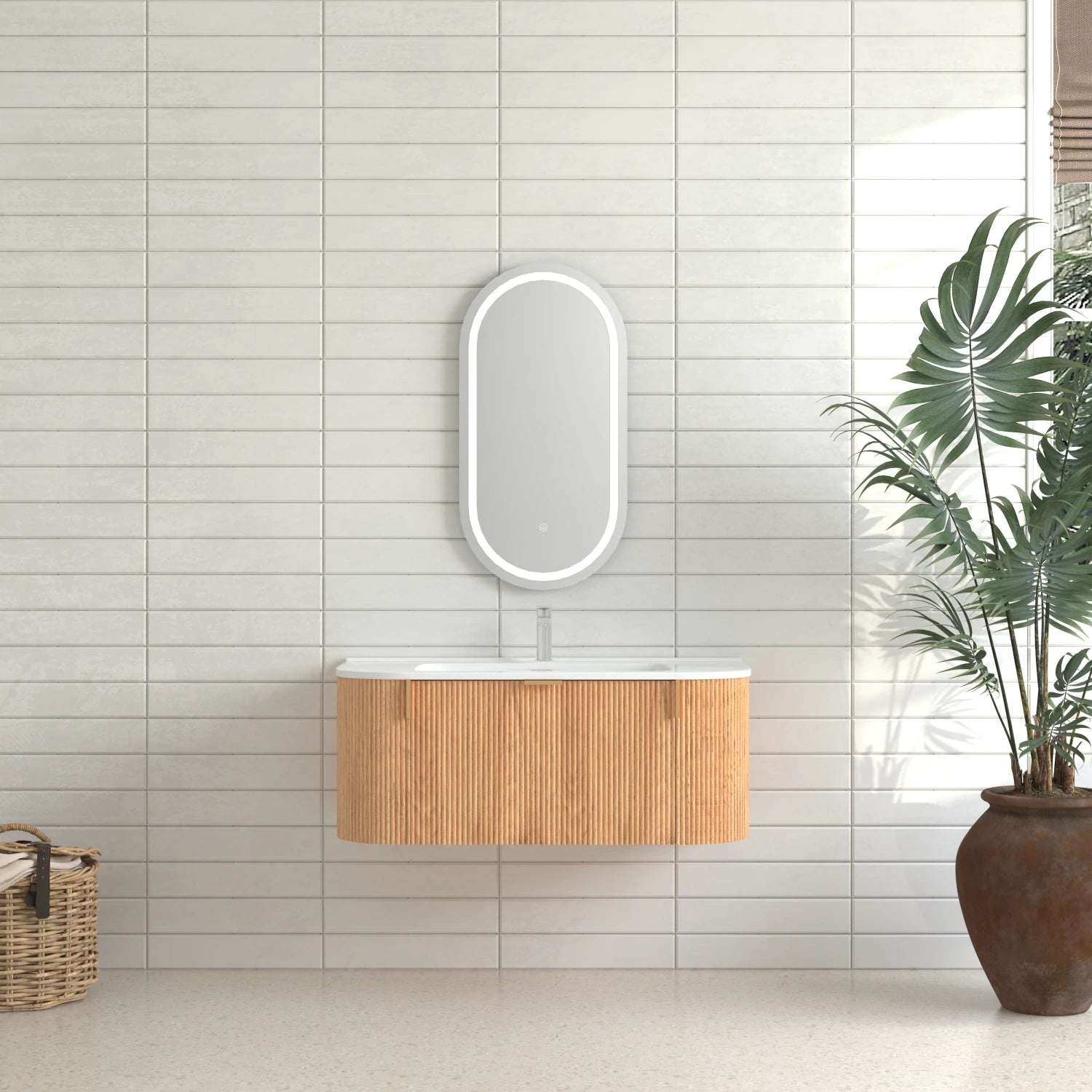The Global Smart Toilet Market: Trends, Growth, and Opportunities
1. Introduction
In recent years, I’ve witnessed a remarkable shift in how we approach everyday hygiene and comfort at home. At the heart of this transformation lies a cutting-edge innovation: the smart toilet. A smart toilet is no longer just a high-end bathroom luxury—it's an intelligent device equipped with advanced features like automatic flushing, bidet washing, heated seats, air drying, and even health monitoring capabilities. These functionalities are often powered by sensors, Wi-Fi connectivity, and integration with home automation systems.
Globally, the smart toilet market is gaining impressive momentum. As consumers around the world become more health-conscious and convenience-driven, the demand for smart bathroom technology continues to rise. According to recent industry data, the market has experienced consistent growth, with Asia-Pacific leading the way, followed by strong adoption in North America and parts of Europe. Even emerging regions like the Middle East and South America are showing increasing interest in smart toilet installations.
What fascinates me most is how smart toilets align perfectly with the broader smart home trend. In a world where we control lighting, security, and appliances with a voice command or smartphone app, it makes perfect sense that our bathrooms evolve too. The smart toilet is not just about comfort—it represents the intersection of hygiene, technology, and sustainable living.
2. Market Overview
As I explore the dynamics of the global smart toilet market, it’s clear that we’re looking at a rapidly expanding industry with significant potential. In 2024, the market was valued at approximately USD 6.2 billion, and projections suggest it could reach well over USD 10 billion by 2030, growing at a steady CAGR of around 8–10%. This growth is fueled by rising consumer awareness of hygiene, increased smart home adoption, and demand for modern bathroom solutions across both residential and commercial sectors.
Market Segmentation
From my perspective, understanding how the market is segmented helps identify where the real opportunities lie. Geographically, the Asia-Pacific region leads the smart toilet industry, thanks to early adoption in countries like Japan, South Korea, and China. Meanwhile, North America and Europe are catching up quickly due to lifestyle upgrades, tech integration, and health-conscious consumers. Emerging regions such as the Middle East, Latin America, and parts of Africa are showing promising growth as infrastructure and awareness improve.
In terms of product types, the market includes:
- Wall-hung smart toilets
- Floor-mounted smart toilets
- Integrated bidet smart toilets
- Retrofit smart toilet seats
Each category addresses different user preferences, budget ranges, and installation scenarios, expanding the market’s reach across various customer segments.
As for end-users, smart toilets are gaining traction in:
- Residential settings – homeowners looking for luxury and convenience
- Commercial applications – including hotels, airports, hospitals, and offices that prioritize hygiene and smart facilities
I’ve also seen a growing interest from senior living communities and healthcare institutions due to the health-monitoring features offered by high-end models.
Key Industry Players
Several major brands are shaping the direction of the smart toilet industry. Leading the pack are global players such as TOTO Ltd., Kohler Co., Duravit, Roca, and Villeroy & Boch. These companies continue to push the envelope by introducing innovative features, enhancing user experience, and expanding their product lines to meet regional demands.
In addition, a number of regional manufacturers and emerging startups are entering the scene with affordable and tech-enabled smart toilet solutions, which is further intensifying competition and driving innovation across the board.
3. Key Trends Shaping the Market
As someone who closely follows the smart toilet industry, I’ve observed several powerful trends that are driving market growth and transforming how people interact with bathroom technology. These trends are not just reshaping consumer expectations—they’re also creating exciting opportunities for businesses and manufacturers worldwide.
Integration with IoT and Home Automation
One of the most noticeable developments is the seamless integration of smart toilets with IoT and smart home systems. More and more households are using digital assistants like Alexa or Google Home to control their appliances—and now, even their toilets. From personalized seat temperatures to automatic lid controls, today’s smart toilets are becoming intelligent hubs within a fully connected home environment.
Growing Health Consciousness and Hygiene Demand
The pandemic accelerated the global shift toward health-conscious and hygienic living, and smart toilets are at the center of this transformation. I’ve seen a sharp increase in demand for features like automatic bidet washing, UV sterilization, and deodorization systems. Some high-end models even monitor urine composition or body temperature—blurring the lines between wellness and bathroom tech.
Voice-Activated and App-Controlled Features
What once sounded futuristic is now a reality. Voice-activated and app-controlled toilets are becoming more common, offering users greater convenience and personalization. Whether it’s adjusting spray settings, managing cleaning schedules, or accessing usage data, mobile apps are giving users full control at their fingertips. Personally, I find this not just a luxury, but a major step toward accessible and user-friendly hygiene technology.
Sustainable and Water-Efficient Designs
Another trend that stands out is the industry’s growing commitment to sustainability and water efficiency. Many smart toilets are now designed with dual-flush systems, eco modes, and smart sensors that reduce water consumption without compromising cleanliness. This not only appeals to environmentally conscious consumers but also aligns with green building standards in commercial and residential developments.
Rise of Touchless and Self-Cleaning Technology
In today’s hygiene-focused world, the popularity of touchless toilets and self-cleaning features is skyrocketing. From motion-activated lids to auto-flushing and bowl-cleaning functions, these technologies help minimize the spread of germs and make cleaning routines easier for users. I believe this trend will continue to evolve, especially in high-traffic public and commercial spaces where hygiene is a top priority.
Overall, these smart toilet market trends signal a shift in consumer mindset—from viewing bathrooms as basic utility spaces to seeing them as high-tech, wellness-centered environments. And from where I stand, this is just the beginning.
4. Regional Market Insights
As I analyze the global smart toilet market, one thing becomes clear: regional dynamics play a critical role in shaping both demand and innovation. Each region has its own unique consumer behavior, adoption rate, and level of market maturity. Let me walk you through the most notable regional insights I’ve observed.
Asia-Pacific Leads the Way
Without a doubt, the Asia-Pacific region remains the dominant force in the smart toilet industry. Countries like Japan, South Korea, and China are not just major markets—they’re trendsetters. Japan, in particular, pioneered intelligent toilet technology decades ago, with companies like TOTO setting global benchmarks in innovation and comfort. In South Korea and China, I’ve seen growing government support, urban development, and a strong culture of tech adoption driving massive growth in smart bathroom products.
What’s impressive is how consumers in these regions view smart toilets as essential, not just optional. Whether it’s for hygiene, convenience, or status, the demand here is deeply embedded in lifestyle choices.
North America and Europe Catching Up
In North America and Europe, the smart toilet market is evolving rapidly. While adoption started slower than in Asia, I’ve noticed significant acceleration in recent years—especially in urban centers and among higher-income households. Consumers in these regions are now prioritizing smart home integration, sustainability, and wellness, all of which align perfectly with what smart toilets offer.
In the U.S. and Canada, demand is growing in both residential and commercial sectors. Luxury homeowners, hospitality chains, and wellness spas are leading the charge. Meanwhile, European countries are emphasizing eco-friendly and water-saving technologies, which is pushing manufacturers to develop smart toilets that meet stringent environmental standards.
Emerging Potential in Latin America and the Middle East
While still in early stages, markets in Latin America and the Middle East are beginning to show exciting potential. I’ve seen rising awareness about hygiene and smart technology in countries like the UAE, Saudi Arabia, Brazil, and Mexico. Economic growth, tourism development, and increasing investment in smart infrastructure are creating favorable conditions for smart toilet adoption in these regions.
Although these markets face some barriers—such as affordability and distribution challenges—many brands are targeting them with affordable smart toilet models and educational marketing to build long-term interest.
From where I stand, regional differences are not limitations—they’re opportunities. Businesses that understand the cultural and economic nuances of each market will be best positioned to thrive in the evolving global smart toilet landscape.
5. Market Drivers and Challenges
As I’ve followed the evolution of the smart toilet market, it’s become clear that its growth is being fueled by a combination of powerful forces—some pushing it forward, and others slowing it down. To truly understand where this industry is headed, we need to examine both sides of the equation: the key drivers and the challenges that still need to be overcome.
Key Market Drivers
Urbanization and Smart Infrastructure
One of the most influential factors behind the rise of smart toilets is rapid urbanization. As cities grow and modernize, the demand for high-tech, space-efficient, and hygienic bathroom solutions increases. I’ve seen smart toilets become a standard feature in luxury high-rise apartments, hotels, and newly built homes in urban areas around the world.
Aging Population and Health Needs
Another major driver is the world’s aging population. Elderly consumers are looking for more comfortable and accessible bathroom solutions, and smart toilets deliver just that. With features like automated flushing, bidet functions, and even health monitoring sensors, these products provide greater independence and dignity to seniors—something I believe is becoming increasingly valuable in today’s aging societies.
Growing Demand for Luxury and Comfort
Today’s consumers are also drawn to luxury features and personalized comfort. Heated seats, ambient lighting, auto-deodorization, and app-controlled preferences are no longer considered extravagant—they’re becoming expected in premium homes and hotels. This demand for an elevated bathroom experience is pushing manufacturers to innovate further and bring smarter, more luxurious designs to market.
Ongoing Market Challenges
High Costs and Affordability
Despite all the benefits, one of the biggest barriers I’ve observed is the high cost of smart toilets. Advanced features come with a price, and for many consumers—especially in developing markets—these products are still out of reach. Affordability remains a key hurdle to achieving widespread adoption.
Lack of Consumer Awareness
Another challenge is the general lack of awareness around what smart toilets can actually offer. Many consumers still associate toilets with basic functionality and don’t realize how transformative smart features can be for hygiene, health, and convenience. Bridging this knowledge gap through education and marketing is essential for driving demand.
Installation and Compatibility Issues
Lastly, I’ve seen installation complexity slow down adoption in certain markets. Some smart toilets require specific plumbing, electrical connections, or structural support—making them difficult to retrofit into older buildings. This is especially problematic in regions where bathroom layouts or infrastructure are outdated.
In my view, these challenges aren’t deal-breakers—they’re opportunities for the industry to evolve. As technology becomes more affordable and user-friendly, and as consumer education improves, I believe the smart toilet market will continue its upward trajectory worldwide.
6. Growth Forecast and Projections (2025–2030)
Looking ahead, I believe the global smart toilet market is set for steady and meaningful growth between 2025 and 2030. The combination of consumer demand, smart home integration, and health-focused innovation points to a bright future for this industry.
Strong CAGR and Market Expansion
Based on current data and what I’ve seen in industry trends, the market is expected to grow at a compound annual growth rate (CAGR) of approximately 8–10% during the forecast period. In monetary terms, the smart toilet market—valued at around USD 6.2 billion in 2024—is projected to reach well over USD 10 billion by 2030. This growth is being fueled by rising urbanization, increased health awareness, and a surge in luxury bathroom upgrades across residential and commercial spaces.
Regional Projections
From a regional standpoint, I anticipate continued dominance by the Asia-Pacific region, particularly Japan, South Korea, and China. These markets already have high penetration rates and will likely maintain leadership through technological innovation and consumer loyalty.
North America is expected to experience significant growth, with more homeowners and developers integrating smart toilets into high-end properties and wellness-focused living spaces. Meanwhile, Europe will likely see moderate but consistent expansion, driven by eco-conscious design trends and supportive regulations around water efficiency.
Emerging regions such as the Middle East, Latin America, and Southeast Asia are poised to grow at a faster pace in terms of percentage. While these markets currently have a smaller share, I see them as untapped opportunities that will expand quickly as awareness and accessibility improve.
Residential vs. Commercial Market Share
When I look at usage segmentation, the residential sector currently holds the largest market share, and I expect it to remain dominant throughout the forecast period. As smart homes become more common and consumers seek convenience and hygiene at home, residential smart toilet installations will keep rising—especially in luxury and mid-range developments.
However, the commercial sector is catching up fast. I’ve seen growing demand in premium hotels, upscale office buildings, airports, and even healthcare facilities. The emphasis on touchless and self-cleaning technology makes smart toilets a smart investment in public and semi-public spaces where hygiene is a top priority.
In summary, I see the next five years as a time of rapid development and opportunity for the smart toilet market. Businesses that focus on innovation, affordability, and regional strategy will be well-positioned to thrive in this expanding global landscape.
7. Opportunities for Businesses
As someone who’s watched the smart toilet market evolve from a niche luxury to a fast-growing global segment, I see a range of exciting opportunities for businesses aiming to enter or expand in this space. Whether you’re a manufacturer, distributor, retailer, or investor, there’s real potential to tap into growing demand with the right approach.
OEM and ODM Partnership Potential
One of the most promising routes I’ve observed is through OEM (Original Equipment Manufacturer) and ODM (Original Design Manufacturer) partnerships. Many brands are looking to expand their product lines without building manufacturing capabilities from scratch. For established manufacturers, this creates a great opportunity to provide white-labeled smart toilets to global brands seeking rapid market entry. Customization, branding flexibility, and speed-to-market are key advantages in these collaborations.
Expansion in Wellness and Healthcare Facilities
Another major opportunity lies in the wellness and healthcare sectors. With an aging population and increased awareness of hygiene, smart toilets with features like bidet washing, auto-cleaning, and health monitoring can significantly improve patient comfort and infection control in hospitals, elderly care centers, and rehabilitation facilities. I see this as an untapped vertical where smart toilet technology can move from luxury to necessity.
Growth in E-Commerce and Direct-to-Consumer Sales
Thanks to changing consumer behavior and digital transformation, the e-commerce and DTC (direct-to-consumer) channels are booming. Consumers are researching, comparing, and buying smart toilets online more than ever. For brands and retailers, this means a chance to reach tech-savvy customers directly—especially when supported by strong content, reviews, installation guides, and post-sale support. I believe companies that invest in digital presence and user experience will gain a significant edge.
Potential for Affordable Models in Emerging Regions
Lastly, there’s a massive opportunity to capture market share in emerging regions by introducing affordable smart toilet models. While high-end products still dominate the conversation, many consumers in Latin America, Southeast Asia, and the Middle East are eager to experience smart bathroom technology—provided it comes at a more accessible price point. Simplified models with core smart features can open up entirely new customer segments.
In my view, businesses that embrace innovation, adapt to regional demands, and focus on practical solutions have a unique opportunity to shape the future of the smart toilet industry. The demand is real—and it’s only just beginning.
8. Competitive Landscape
As I’ve explored the global smart toilet market, one thing is clear: competition is intensifying, and it’s pushing the entire industry forward. From established giants to emerging tech innovators, a diverse range of players are shaping this space through aggressive strategies, cutting-edge R&D, and bold partnerships. Let’s take a closer look at who’s leading—and how they’re doing it.
Key Brands and Market Strategies
Some of the most recognized names in the smart toilet industry include TOTO Ltd., Kohler Co., Roca, Duravit, Villeroy & Boch, and American Standard. These brands are leveraging their reputations, global distribution networks, and deep R&D budgets to maintain leadership positions. From my perspective, TOTO remains the industry pioneer, thanks to decades of innovation and a strong foothold in both Asia and the West.
Meanwhile, companies like Kohler are emphasizing design-forward innovation, targeting premium customers with sleek aesthetics and app-controlled features. Newer players, especially from China and South Korea, are entering the market with cost-effective smart toilet models that appeal to younger, tech-savvy consumers and price-sensitive regions.
Innovations and Patent Activity
The pace of innovation and patent filings in this industry is impressive. I’ve seen patents related to touchless operation, water-saving flushing systems, AI-driven health monitoring, and automatic cleaning solutions grow steadily over the past few years. This surge in R&D is not only driving product differentiation—it’s also raising the bar for quality and performance.
Many manufacturers are now integrating IoT, machine learning, and biometric sensors into their designs, transforming smart toilets into health tech devices. These innovations are helping brands position themselves as part of the wellness and smart home ecosystems, not just the bathroom fixture market.
M&A Trends and Strategic Alliances
Another trend I’ve noticed is a rise in mergers, acquisitions, and strategic partnerships aimed at expanding product lines, geographic reach, or technological capabilities. For instance, established sanitaryware companies are partnering with tech firms to co-develop smarter, more connected bathroom solutions. Others are acquiring local players in emerging markets to strengthen their distribution and adapt to regional preferences more efficiently.
These alliances are also a smart way to navigate regulatory environments, logistics challenges, and consumer education gaps in new markets. In my opinion, collaboration—not just competition—will define the next phase of this industry’s expansion.
Overall, the competitive landscape is becoming more dynamic, more global, and more innovation-driven. For anyone entering or operating in the smart toilet space, staying agile, investing in R&D, and keeping a close eye on evolving customer needs will be critical for long-term success.
9. Conclusion
After closely following the evolution of the global smart toilet market, I’m more convinced than ever that this industry holds enormous potential. What began as a luxury niche is now transforming into a mainstream solution, driven by a mix of technological advancement, health-conscious consumers, and the rise of smart living. From Asia-Pacific’s leadership to North America and Europe’s growing adoption, and even the promising growth in emerging regions—the momentum is undeniable.
The market is projected to surpass USD 10 billion by 2030, with a strong CAGR and diversified demand across residential and commercial sectors. Features like touchless operation, app control, self-cleaning systems, and water-saving designs are no longer futuristic concepts—they're becoming standard expectations. And as consumer awareness increases, so will the demand for smarter, cleaner, and more connected bathroom experiences.
Encouraging Stakeholders to Act
For manufacturers, distributors, retailers, and investors, I see a golden window of opportunity. Now is the time to innovate, localize, and lead. Whether it’s through OEM/ODM partnerships, product expansion in healthcare and hospitality, or affordable smart toilet models for emerging markets—the paths to growth are many. Those who tap into the growing synergy between hygiene, convenience, and smart technology will be well-positioned to lead the next chapter of this industry.
Final Thoughts
In my view, the future of the smart toilet market is not just about adding tech to a bathroom fixture—it’s about redefining comfort, wellness, and sustainability in our daily routines. As lifestyles continue to evolve, and as consumers expect more from every space in their home, smart toilets will no longer be a novelty—they’ll be the new norm.
For those ready to embrace the innovation-driven demand, the smart toilet industry offers not just growth—but leadership, transformation, and long-term value.
Featured Products
AISU Smart Bidet Toilet with Remote Control.Raised Tankless Toilet with LED Display
- $522.68
- $522.68
- Unit price
- / per
AISU One Piece Heated Seat Smart Toilet, White
- $364.79
- $364.79
- Unit price
- / per
AISU Smart Toilet with Foot Sensor Flush, Blue Night Light, White
- $366.72
- $366.72
- Unit price
- / per
AISU One-Piece 1.28 GPF Single Flush Egg Shape Toilet
- from $481.74
- from $481.74
- Unit price
- / per
-
Glossy White
-
Glossy Black
AISU Smart Toilet with Heated Bidet Seat, Portable toilet with bidet built in AUTO Open&Close, AUTO Dual Flush, Bidet toilet with Dryer and Warm Water, White
- $642.24
- $642.24
- Unit price
- / per
AISU 1.28 GPF Tornado Flush Two-piece Toilet for bathrooms, Gloss White
- $236.91
- $236.91
- Unit price
- / per
AISU 1.1/1.6 GPF Tornado Flush One-Piece Toilet Elongated, Siphonic S-trap 12", Soft Closing Seat, Button on Tank top, Powerful Dual Flush MAP 1000g, Comfort Chair Seat ADA Height 17", Glossy White
- $372.43
- $372.43
- Unit price
- / per
